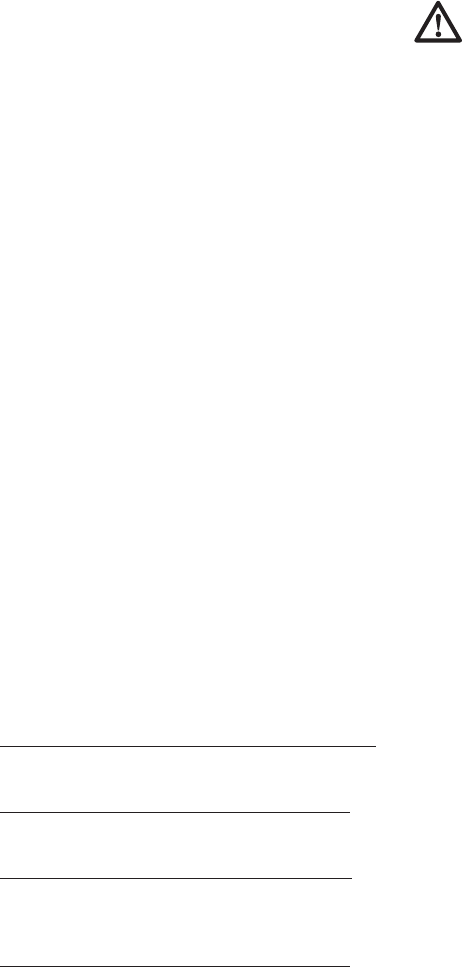
26
• USE RECOMMENDED ACCESSORIES. Consult
the instruction manual for recommended accessories.
The use of improper accessories may cause risk of
injury to persons.
• NEVER STAND ON TOOL. Serious injury could occur
if the tool is tipped or if the cutting tool is unintention-
ally contacted.
• CHECK DAMAGED PARTS. Before further use of the
tool, a guard or other part that is damaged should be
carefully checked to determine that it will operate prop-
erly and perform its intended function—check for
alignment of moving parts, binding of moving parts,
breakage of parts, mounting and any other conditions
that may affect its operation. A guard or other part that
is damaged should be properly repaired or replaced.
Do not use tool if switch does not turn it on and off.
• NEVER LEAVE TOOL RUNNING UNATTENDED.
TURN POWER OFF. Don’t leave tool until it comes to
a complete stop.
• DO NOT OPERATE ELECTRIC TOOLS NEAR
FLAMMABLE LIQUIDS OR IN GASEOUS OR
EXPLOSIVE ATMOSPHERES. Motors in these tools
may spark and ignite fumes.
• USE PROPER EXTENSION CORDS. Make sure
your extension cord is in good condition. When using
an extension cord, be sure to use one heavy enough
to carry the current your product will draw. An under-
sized cord will cause a drop in line voltage resulting in
loss of power and overheating. The following table
shows the correct size to use depending on cord
length and nameplate ampere rating. If in doubt, use
the next heavier gage. The smaller the gage number,
the heavier the cord.
Minimum Gage for Cord Sets
Volts Total Length of Cord in Feet
120V~ 25 26-50 51-100 101-150
220V~ 50 51-100 101-200 201-300
Ampere Rating
More Not more American Wire Gage
Than Than
0 - 6 18 16 16 14
6 - 10 18 16 14 12
10 - 12 16 16 14 12
12 - 16 14 12 Not Recommended
Additional Safety Rules For Miter Saws
CAUTION: FAILURE TO HEED THESE
WARNINGS MAY RESULT IN PERSONAL
INJURY AND SERIOUS DAMAGE TO THE SAW.
• DO-Protect electric supply line with at least a 15
ampere time-delay fuse or a circuit breaker.
• DO-Make certain the blade rotates in the correct
direction and that the teeth at the bottom of the blade
are pointing to the rear of the miter saw.
• DO-Be sure all clamp handles are tight before starting
any operation.
• DO-Be sure all blade and clamp washers are clean
and recessed sides of collars are against blade.
Tighten arbor screw securely.
• DO-Keep saw blade sharp.
• DO-Keep motor air slots free of chips and dirt.
• DO-Use blade guards at all times.
• DO-Keep hands out of path of saw blade.
• DO-Shut off power, disconnect cord from power
source and wait for saw blade to stop before
servicing or adjusting tool.
• DO-Support long work with an outboard tool rest.
• DO-Use only 10 inch diameter blades.
• DON’T-Attempt to operate on anything but
designated voltage.
• DON’T-Operate unless all clamp handles are tight.
• DON’T-Use blades larger or smaller than those which
are recommended.
• DON’T-Wedge anything against fan to hold motor
shaft.
• DON’T-Force cutting action. (Stalling or partial stalling
of motor can cause major damage. Allow motor to
reach full speed before cutting.)
• DON’T-Cut ferrous metals (Those with any iron or
steel content) or any masonry.
• DON’T-Use abrasive wheels. The excessive heat and
abrasive particles generated by them will damage
saw.
• DON’T-Allow anyone to stand behind saw.
• DON’T-Apply lubricants to the blade when it’s running.
• DON’T-Place either hand in the blade area when the
saw is connected to the power source.
• DON’T-Use blades rated less than 5500 R.P.M.
• DON’T-Attempt to cut small pieces (hand within 6" of
blade) without clamping.


















